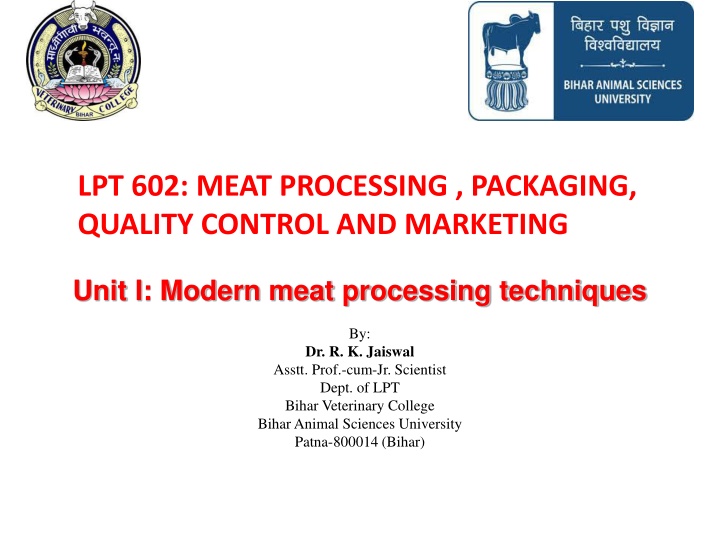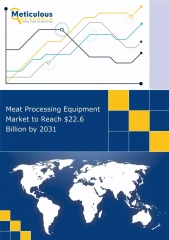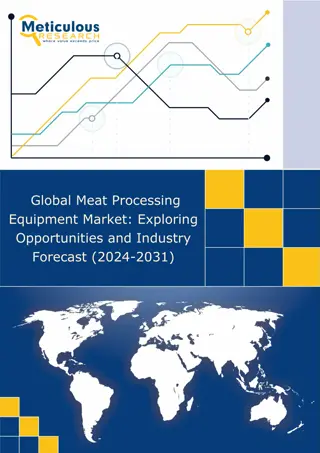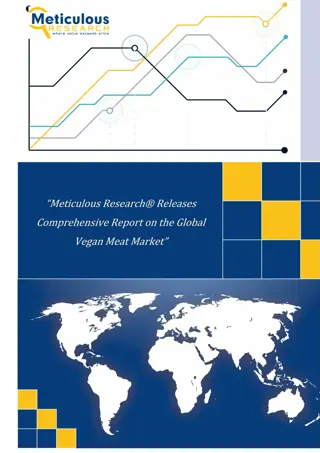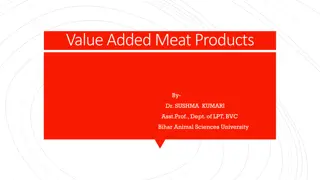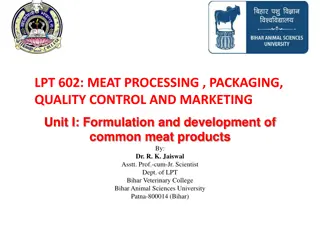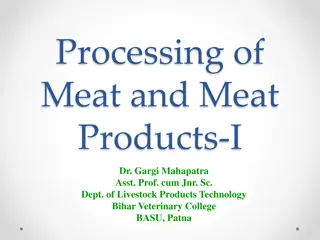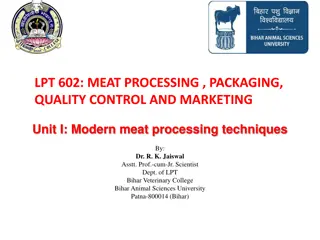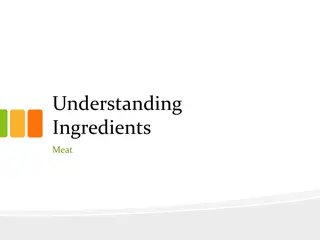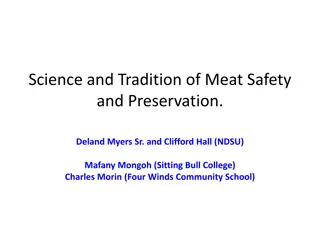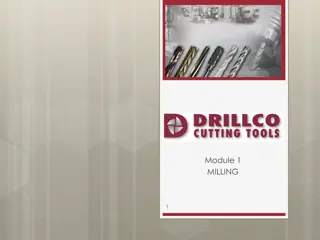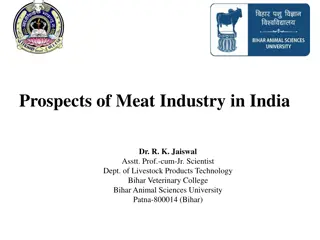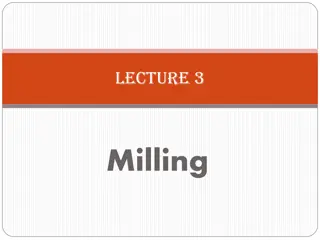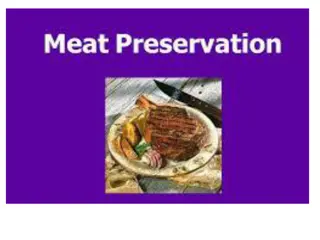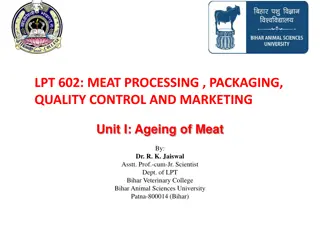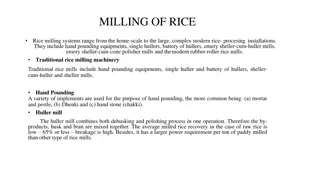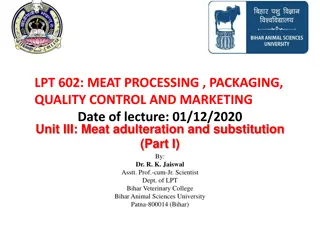Modern Meat Processing Techniques: Comminution, Milling, Chopping
The modern meat processing techniques involve comminution of meat cuts to enhance texture and quality. Mincing, milling, and chopping are key processes that help in achieving uniformity, texture, and binding of meat products. Different technologies such as meat mincers, millers, and choppers are utilized for these processes, resulting in the production of high-quality meat products.
Download Presentation

Please find below an Image/Link to download the presentation.
The content on the website is provided AS IS for your information and personal use only. It may not be sold, licensed, or shared on other websites without obtaining consent from the author.If you encounter any issues during the download, it is possible that the publisher has removed the file from their server.
You are allowed to download the files provided on this website for personal or commercial use, subject to the condition that they are used lawfully. All files are the property of their respective owners.
The content on the website is provided AS IS for your information and personal use only. It may not be sold, licensed, or shared on other websites without obtaining consent from the author.
E N D
Presentation Transcript
LPT 602: MEAT PROCESSING , PACKAGING, QUALITY CONTROL AND MARKETING Unit I: Modern meat processing techniques By: Dr. R. K. Jaiswal Asstt. Prof.-cum-Jr. Scientist Dept. of LPT Bihar Veterinary College Bihar Animal Sciences University Patna-800014 (Bihar)
MODERN PROCESSING TECHNOLOGIES IN COMMINUTION OF MEAT Comminution of meat (less noble cuts), trimmings from noble cuts of meat, offals and fat result in the following useful effects: Uniformity in size and shape, rendering them more attractive. Breaking up of connective tissue making it less obtrusive Mincing fat and meat together, so as to make large to moderate to large proportions of fat less obtrusive Comminuted lean meat binds the whole mixture together especially in the presence of salt. The texture and eating quality of the products are therefore superior to the raw materials used and are hence more desirable to consumers. Comminuted meat products may be further classified as coarsely ground or finely ground meat products (emulsion based meat products). The different technologies utilised in comminution of meat include Mincing, Milling Chopping, and Flaking.
Mincing Mincing or grinding, the first step in development of comminuted meat products usually, is undertaken in a mincer, which consist of screw conveyor housed in a chamber, and a rotating inner plate of knives at one end of the conveyor. Considerable pressure is put on the meat in the screw feed chamber. Tearing occurs between the screw flights and the chamber. Final comminution occurs when portions of the meat extruded through the rotating inner plate of knives are either passed on through holes in the fixed outer plate or sheared off as the holes pass out of register. Thus, there is great tearing, pressure and great shearing and the meat is not cut cleanly or finely. Connective tissue is fairly well divided in a sharp mincer, but may be troublesome in a blunt one. Minced meat can be used for development of coarse ground meat products, or may be further chopped in a bowl chopper to produce emulsion based meat products.
Milling A miller is used for milling of meat and a miller is very similar to meat mincer, except that : There is no feed screw; the plates are mounted horizontally and fed by the weight of material above. A rotating knife which moves at much higher speed; Some cutting or tearing action in the space between the plates as well as at the edges of the holes in them. There is finer comminution than in a mincer and the operation is much faster. The fineness of comminution and intimate mixing, when used with fatty materials, these machines may be referred to as emulsifiers. These are extremely suitable to manufacture patties.
Chopping Chopping is undertaken in chopper, which are of two types Rotary Bowl Chopper and Stationary Chopper A rotary bowl chopper consists of three or more curved knives rotating at high speed in vertical plane close to the surface of a curved bowl which itself rotates slowly in a horizontal plane. In addition to the vigorous cutting action of the knives, the massaging effect of the side of the knives on the mass of chopped meat may be important. Satisfactory chopping temperatures range from -1 C to + 22 C. Colder temperatures lead to damage to knives; while warmer temperatures lead to over chopping of fatty tissue and release of free fat. Advanced designs possess the property of chopping under vacuum. Chopping is finally undertaken to produce the emulsion to manufacture emulsion based meat products.
Flaking Flaking is undertaken either in an impeller flaker or a block flaker, and flaking is carried out cut slivers of meat of constant thickness and parallel sides. An impeller flaker consists of an impeller which propels the motion of the meat fed into the machine, to the sharp edges of knives arranged in a static ring. The thickness of the slivers can be adjusted by adjusting the ring of knives. Connective tissue is also cut clean. A block flaker is used to cut slivers of meat from frozen blocks. The flakes produced are coarse than that of an impeller flaker. A guillotine cuts flakes from the end of a frozen block.
MODERN PROCESSING TECHNOLOGIES IN CURING OF MEAT Massaging Massaging involves frictional energy resulting from meat pieces rubbing together. Meat massagers are vats that contain a mechanism for the slow stirring of meat pieces. The stirring arms or paddles are made to set at various configurations. This process is a gentler form of mechanical energy output and is very suitable for the production of whole muscled cured products.
Tumbling Tumbling is a more severe type of physical treatment Tumbling involves the use of impact energy from meat pieces falling and striking baffles or paddles contained in a rotating drum. Tumbling aids the extraction of proteins as in massaging, and thus tenderness and juiciness. resulting enhances
Mixing Mixing imparts a rather vigorous mechanical energy to the product. Mixers possess some type of paddles or ribbons that rotate around a metal shaft. Short mixing times are usually the rule as they tend to tear up whole muscle products. It is most suitable to manufacture sausage type products
